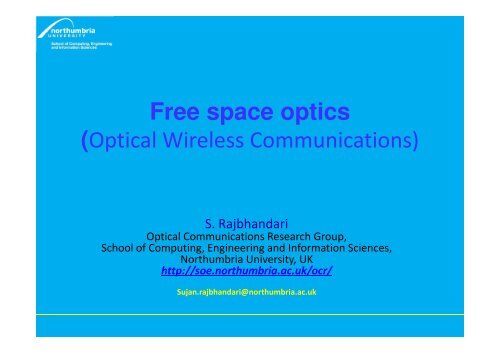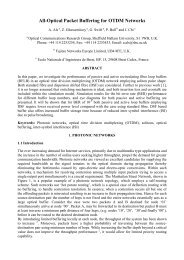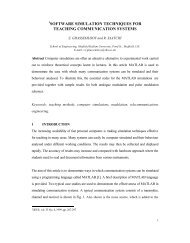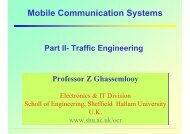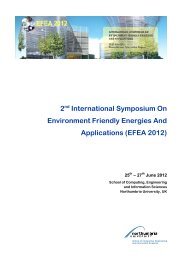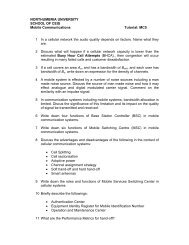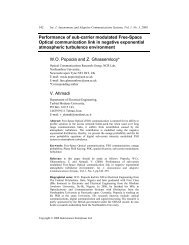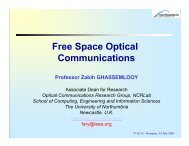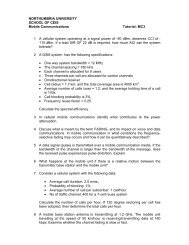Introduction to Optical Wireless communicaitons - Northumbria ...
Introduction to Optical Wireless communicaitons - Northumbria ...
Introduction to Optical Wireless communicaitons - Northumbria ...
You also want an ePaper? Increase the reach of your titles
YUMPU automatically turns print PDFs into web optimized ePapers that Google loves.
Free space optics<br />
(<strong>Optical</strong> <strong>Wireless</strong> Communications)<br />
S. Rajbhandari<br />
<strong>Optical</strong> Communications Research Group,<br />
School of Computing, Engineering and Information Sciences,<br />
<strong>Northumbria</strong> University, UK<br />
http://soe.northumbria.ac.uk/ocr/<br />
Sujan.rajbhandari@northumbria.ac.uk
His<strong>to</strong>ry of <strong>Optical</strong> Communication<br />
• Alexander Graham Bell 1878 more<br />
than 25 years before Reginald<br />
Fessenden did the same thing<br />
with radio 1 .<br />
Diagram of pho<strong>to</strong>phone from Bell paper 1<br />
• Development of LASER in 60’s, optical fibre and semiconduc<strong>to</strong>r has made the<br />
modern communication possible.<br />
• The modern era of indoor wireless optical communications was proposed in<br />
1979 by F.R. Gfeller and U. Bapst 2 . In fact it was the first LAN proposed using<br />
any medium.<br />
1<br />
Alexander Graham BELL, American Journal of Sciences, Third Series, vol. XX, no.118, Oct. 1880, pp. 305- 324.<br />
2<br />
F. R. Gfeller and U. Bapst, Proceedings of the IEEE, vol. 67, pp. 1474- 1486, 1979.
His<strong>to</strong>ry of OWC<br />
800BC Fire beacons (ancient Greeks and Romans)<br />
150BC Smoke signals (American Indians)<br />
1880 Alexander Graham Bell demonstrated the pho<strong>to</strong>phone 1 – 1 st FSO<br />
(THE GENESIS)<br />
1960s Invention of laser (revolutionized FSO), and optical fibre<br />
1970s FSO mainly used in secure military applications<br />
1979 Indoor OWM systems – F R Gfeller and G Bapst<br />
1993 Open standard for IR data commun. The Infrared Data Association<br />
2003 The Visible Light Communications Consortium (VLCC) – Japan<br />
2008 “hOME Gigabit Access” (OMEGA) Project – EU - Develop global<br />
standards for home networking (infrared and VLC technologies).<br />
2009 IEEE802.15.7 - Call for Contributions on IEEE802.15.7 VLC.
Access Network Bottleneck<br />
LAST<br />
MILE<br />
54 Mbps/100 Mbps/GbE<br />
TeraGig Bandwidth<br />
Corporate LAN<br />
Universities<br />
Hospitals<br />
Businesses<br />
Long Haul Fibre Network<br />
Access<br />
Network<br />
2.5G – 10G<br />
Metro Edge<br />
Metro<br />
Network<br />
•Bandwidth hungry applications<br />
•100M/GbE LANS<br />
•HDTV<br />
Bottleneck<br />
•Sufficient bandwidth on most<br />
routes<br />
•DWDM used <strong>to</strong> upgrade<br />
congested routes<br />
•Abundant capacity<br />
•Falling bandwidth<br />
price
RF Bandwidth Congestions
Access Network Technologies<br />
Bandwidth<br />
10 Gbps<br />
FREE SPACE OPTICS<br />
FTTH<br />
1 Gbps<br />
100 Mbps DSL<br />
UWB<br />
10 Mbps<br />
LMDS<br />
1 Mbps<br />
DSL<br />
PLC<br />
50 m 500 m 1 km 2 km 5 km +<br />
Distance from metro fibre route
OWC: Overview<br />
• light beams (visible and infrared)<br />
• propagated through the free space.<br />
• <strong>Optical</strong> transmitter<br />
- Light Emitting Diodes (LED)<br />
- Laser Diodes (LD)<br />
Typical optical wireless system components<br />
• <strong>Optical</strong> receiver<br />
- p-i-n Pho<strong>to</strong>diodes.<br />
- Avalanche Pho<strong>to</strong>diodes<br />
• Links<br />
- Line-of-sight(LOS)<br />
- Non-LOS<br />
- Hybrid<br />
<strong>Optical</strong> wireless connectivity 1<br />
1<br />
M. Kavehrad, Scientific American Magazine, July 2007, pp. 82-87.
OWS<br />
Source: T. Lüftner, "Edge Position Modulation for <strong>Wireless</strong> Infrared<br />
Communications," PhD thesis, Friedrich-Alexander University, 2005.
Comparison with RF<br />
Property Radio Infrared Implication for IR<br />
Bandwidth<br />
regulated<br />
Passes through<br />
walls<br />
Yes No Approval not required<br />
world-wide compatibility<br />
Yes No Inherently secure carrier<br />
reuse in adjacent rooms.<br />
Multipath fading Yes No Simple link design<br />
Multipath Yes Yes Problematic at high data<br />
dispersion<br />
rates<br />
Path loss High High<br />
Dominant noise<br />
Average power<br />
proportional <strong>to</strong><br />
Other<br />
users<br />
BackgroundShort range<br />
f(t)is the input signal with<br />
high peak-average radio
What OWC offers<br />
• Abundance bandwidth High data rate<br />
• License free operation<br />
• High Directivity small cell size can support multiple devices<br />
within a room<br />
• Free from electromagnetic interference suitable for hospital and<br />
library environment.<br />
• cannot penetrate opaque surface like wall Spatial confinement <br />
Secure data transmission<br />
• Compatible with optical fibre (last mile bottle neck?)<br />
• Low cost of deployment<br />
• Quick <strong>to</strong> deploy<br />
• Small size, low cost component and low power consumptions.<br />
• Simple transceiver design.<br />
• No multipath fading
Applications<br />
Send signal<br />
Send and receive reflection<br />
Simple<br />
Sensors / IR viewer<br />
Source: Internet<br />
EN0630 – <strong>Optical</strong> Communications System Design – Dr. Hoa Le Minh
Applications<br />
Controlling & signalling<br />
Functional<br />
Mobile communications<br />
Source: Internet
OWC- Applications<br />
Other applications include:<br />
<br />
<br />
<br />
<br />
<br />
Disaster recovery<br />
Fibre communications backup<br />
Video conferencing<br />
Links in difficult terrains<br />
Intelligent transport system (car-<strong>to</strong>car<br />
Communications, ground-<strong>to</strong>train<br />
communications)<br />
Last Mile Connectivity<br />
Multi-campus University<br />
Hospitals
<strong>Optical</strong> <strong>Wireless</strong> Communications<br />
OWC<br />
Indoor<br />
Outdoor<br />
VLC IR VLC IR<br />
- Broadcasting<br />
- LOS/Diffuse<br />
(3-4m, 100Mbps)<br />
- Short range<br />
communications<br />
- Device <strong>to</strong> device<br />
- <strong>Wireless</strong> hotspot<br />
(4m, ~1Gbps)<br />
- Traffic light<br />
- Car-<strong>to</strong>-car<br />
communications<br />
(low speed)<br />
- Free space optics<br />
(2-3km, > 1Gbps)
Classification of Indoor OWC Links
LOS Links<br />
Rx<br />
Narrow low power transmit beam<br />
Narrow field-of-view receiver<br />
Tx<br />
Advantages<br />
Least path loss<br />
No multipath propagation<br />
High data rate<br />
Suitable <strong>to</strong> point-<strong>to</strong>-point<br />
communications only.<br />
Problems<br />
Noise is limiting fac<strong>to</strong>r<br />
Possibility of blocking/shadowing<br />
Tracking necessary<br />
No/limited mobility
Diffuse Links<br />
Tx<br />
Rx<br />
Use multiple reflections of the<br />
optical beam on surrounding<br />
surfaces such as ceilings, walls, and<br />
furniture.<br />
transmitter and receiver not<br />
necessarily directed one <strong>to</strong>wards the<br />
other.<br />
<br />
<br />
Robust <strong>to</strong> blocking and shadowing<br />
Allows roaming<br />
Problems:<br />
High path loss.<br />
Multiple paths (reflections)<br />
- Result in inter-symbol interference<br />
(ISI).<br />
High power penalty due <strong>to</strong> ISI.<br />
Limited bandwidth- Due <strong>to</strong> large<br />
capacitance of the large area detec<strong>to</strong>rs
Geometry LOS propagation model<br />
Transmitter<br />
ϕ<br />
d<br />
ψ<br />
ψ c<br />
Receiver
Propagation types and definitions<br />
Definitions<br />
Input<br />
– Transmitter parameters<br />
• Average optical power transmitted (Pt)<br />
• Half power angle (Φ)<br />
• Lambert’s mode number (m l )<br />
– Receiver parameters<br />
• Field Of View (FOV), Ψ<br />
• Receiver effective area (A eff )<br />
• Receiver sensitivity (R)<br />
Output<br />
– Average optical received power (P r )<br />
– Geometrical attenuation<br />
– Channel gain, H(0)<br />
– Link Margin
<strong>Optical</strong> Parameters<br />
Average optical power:<br />
Signal-<strong>to</strong>-noise-ratio:<br />
DC channel gain:
LOS/WLOS link margin analysis<br />
The channel gain (response at null frequency) is:<br />
Geometrical attenuation in dB:<br />
d : distance transmitter/receiver<br />
φ: semi-angle of transmission<br />
ψ : semi-angle of reception<br />
P t : transmitted power<br />
Average optical received power P r :<br />
Link margin M l :
Challenges (Indoor)<br />
Challenges Causes (Possible ) Solutions<br />
Power limitation Eye and skin safety. Power efficient modulation techniques,<br />
holographic diffuser, transreceiver at 1500ns<br />
band<br />
Noise<br />
Intense ambient light<br />
(artificial/ natural)<br />
<strong>Optical</strong> and electrical band pass filters,<br />
Error control codes<br />
Intersymbol<br />
interference (ISI)<br />
No/Limited mobility<br />
Shadowing<br />
Blocking<br />
Limited data rate<br />
Multipath propagation<br />
(non-LOS links)<br />
Beam confined <strong>to</strong> small<br />
area.<br />
LOS links<br />
Large area pho<strong>to</strong>detec<strong>to</strong>rs<br />
Equalization, Multi-Beam Transmitter<br />
Wide angle optical transmitter , MIMO<br />
transceiver.<br />
Diffuse links/ Cellular System/ wide<br />
angle optical transmitter<br />
Bandwidth-efficient modulation techniques<br />
/Multiple small area pho<strong>to</strong>-detec<strong>to</strong>r.<br />
Strict link set-up LOS links Diffuse links/ wide angle transmitter
Safety Classifications - Point Source<br />
Emitter
Issue1: Eye- safety<br />
<br />
<br />
<br />
<br />
Infrared communication currently in market<br />
works in two wavelengths: 800 nm and<br />
1550 nm.<br />
At 800 nm (near infrared), light passed<br />
though cornea and lens and focus on <strong>to</strong><br />
the retina.<br />
Invisible light no blinking reflex.<br />
Retina has no pain sensor permanent<br />
eye-damage could occur.<br />
<br />
<br />
<br />
<br />
Infrared transceivers should conform <strong>to</strong> class 1, a few W,(inherently safe) of<br />
the IEC 825 standard. The eye safety limit is a function of the viewing time,<br />
wavelength and apparent size of the optical source.<br />
Class 3B laser can be used by passing the beam through a hologram.<br />
1550 nm is relatively safe as the wavelength is absorbed by the cornea and<br />
lens.<br />
However, the cheap trans-receiver optical devices available in market are in<br />
800 nm band.
Eye- safety- Possible Solutions<br />
Adopt <strong>to</strong> 1500 nm band (expensive solution)<br />
<br />
Power efficient baseband modulation techniques like pulse position<br />
modulation.<br />
Retransmission scheme and error control code .<br />
Power efficiency is also important fac<strong>to</strong>r for battery powered optical wireless<br />
gadgets as the power consumption needs <strong>to</strong> be minimised.<br />
Combining power efficient modulation scheme with the error control code<br />
can be optimum solution.
Issue 2: Artificial Light Interference (ALI)<br />
<strong>Optical</strong> power spectra of common ambient infrared sources. Spectra<br />
have been scaled <strong>to</strong> have the same maximum value.
ALI-Possible Solutions<br />
Differential receiver 1<br />
Differential optical filtering 2<br />
Electrical high pass filter 3,4<br />
Polarisers 5<br />
Angle diversity receiver 6,7<br />
Discrete wavelet transform based denoising 8,9<br />
1<br />
J. R. Barry, PhD Dissertation, University of California at Berkeley, 1992<br />
2<br />
A.J.C Moreira, R. T. Valadas, A. M. De Oliveira Duarte, <strong>Optical</strong> Free Space Communication Links, IEE Colloquium on ,<br />
vol., no., pp.5/1-510, 19 Feb 1996.<br />
3<br />
R. Narasimhan, M. D. Audeh, and J. M. Kahn, IEE Proceedings - Op<strong>to</strong>electronics, vol. 143, pp. 347-354, 1996.<br />
4<br />
A. R. Hayes, Z. Ghassemlooy , N. L. Seed, and R. McLaughlin, IEE Proceedings - Op<strong>to</strong>electronics vol. 147, pp. 295-<br />
300, 2000.<br />
5<br />
S. Lee, Microwave and <strong>Optical</strong> Technology Letters, vol. 40, pp. 228-230, 2004.<br />
6<br />
R. T. Valadas, A. M. R. Tavares, and A. M. Duarte, International Journal of <strong>Wireless</strong> Information Networks, vol. 4, pp.<br />
275-288, 1997 .<br />
7<br />
J. M. Kahn, P. Djahani, A. G. Weisbin, K. T. Beh, A. P. Tang, and R. You, IEEE Communications Magazine, vol. 36, pp.<br />
88-94, 1998.<br />
8<br />
S. Rajbhandari; Z. Ghassemlooy; and M. Angelova, IJEEE, Vol. 5, no. 2 ,pp102-111. 2009.<br />
9<br />
S. Rajbhandari; Z. Ghassemlooy; and M. Angelova, Journal of Lightwave Technology, on print.
Issue 3: Multipath induced ISI<br />
Diffuse Links offers<br />
Robustness <strong>to</strong> blocking and shadowing<br />
Allows roaming<br />
Avoid complex alignment and tracking<br />
between transmitter and receiver<br />
Challenges<br />
<br />
<br />
<br />
<br />
For most surfaces, the light wave is<br />
diffusely reflected (as from a matter<br />
surface) rather than specularly reflected<br />
(as from a mirrored surface).<br />
Pulse spreading beyond symbol duration.<br />
High inter-symbol interference (ISI).<br />
Low data rate and high power penalty.<br />
Amplitude<br />
1<br />
0.8<br />
0.6<br />
0.4<br />
0.2<br />
0<br />
Transmitted singal<br />
Received signal<br />
0 0.05 0.1 0.15 0.2<br />
Time (µS)
Channel Model and Performance<br />
without an Equalizer<br />
Characterised by Channel impulse response h(t).<br />
Developed by Carruthers and Kahn 1 .<br />
6(0.1D<br />
)<br />
6<br />
h( t)<br />
=<br />
rms<br />
u(<br />
t)<br />
( t + 0.1D<br />
)<br />
7<br />
rms<br />
where u(t) is the unit step function and D rms RMS<br />
delay spread.<br />
Normalized delay spread,<br />
D =<br />
T<br />
D<br />
rms<br />
T s<br />
T s : bit duration.<br />
<br />
<br />
<br />
The normalized optical power requirement for the<br />
unequalized system increases exponentially with<br />
increasing delay spread.<br />
Modulation techniques having shorter pulse<br />
duration show higher power penalties.<br />
It is practically impossible <strong>to</strong> achieve a<br />
reasonable BER at D T > 0.5 for OOK system.<br />
1<br />
J. B. Carruthers and J. M. Kahn, IEEE Transaction on Communication, vol. 45, pp. 1260-1268, 1997.
Reported Working Systems
Long Distance Systems
Common Baseband Digital Modulation<br />
Techniques<br />
OOK<br />
Simple <strong>to</strong> implement<br />
High average power requirement<br />
Suitable for Bit Rate greater tha 30Mb/s<br />
Performance de<strong>to</strong>reaites at higher bit<br />
rates<br />
PPM<br />
Complex <strong>to</strong> implement<br />
Lower average power requirement<br />
Higher transmission bandwidth<br />
Requires symbol and slot synchronisation<br />
DPIM<br />
Higher average power requirement<br />
compared with PPM<br />
Higher throughput<br />
Built in symbol synchronisation<br />
Performance midway between PPM and<br />
OOK.<br />
DH-PIM<br />
The highest symbol throughput<br />
Lower transmission bandwidth than PPM and DPIM<br />
Built in symbol synchronisation<br />
Higher average power requirement compared with PPM and DPIM.<br />
Complex decoder


